We’ve included a few extra diagrams & explanations below for more detail on Abdominal anatomy. To revisit our explanation of key concepts of core strength vs abdominal strength head to our Introduction to the 6-week Core Strength Program.
Your core muscles are made up of many muscle groups including:
The Pelvic floor muscles form the base of your core (internally) and are an important (often overlooked) element in core control.
The diaphragm forms the top of the core and is the lid on the core which helps provide the strength for complex movements. 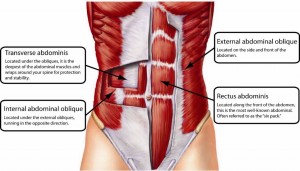
Transverse Abdominus (TA) is the deepest abdominal muscles that wraps around the body (transversely) and responsible for stability & facilitating a strong base for athletic movement.
The Multifidus Muscle is a thin, yet stiff, core muscle deep in the spine. It stabilizes each joint, makes each vertebra work more effectively, and reduces the degeneration of the joint structures.
External Obliques muscles are on the side and front of the abdomen, around your waist, and facilitate twisting movements of the torso.
The Internal Obliques muscles are underneath the external obliques, running in the opposite direction.
The Rectus Abdominus is responsible for flexion (or a crunching action) and runs from the bottom of the ribs to the front of the pelvis along the front of the stomach. This is the ‘six-pack’ part that’s visible for those machines with very low body fat.
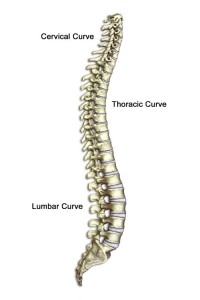 Transversospinalis muscles (ie they run along the spine) are a group of muscles, which extend and rotate the spine, and help protect it from injury. These muscle groups include the multifidus, semispinalis, interspinales, and the intertranversarii. They connect the vertebra and allow an amazing amount of movement & support the all important spine.
Transversospinalis muscles (ie they run along the spine) are a group of muscles, which extend and rotate the spine, and help protect it from injury. These muscle groups include the multifidus, semispinalis, interspinales, and the intertranversarii. They connect the vertebra and allow an amazing amount of movement & support the all important spine.
The normal curves of the spine can be seen in this image (left). The front of the body is to the right. So you can see the lumber curve in the lower spine on the left (what would be the back).
The importance of a good Transversus abdominis activation – by Laura Lo Bianco
Both abdominal and spine muscles play a key roll in the form and function of the trunk and the movement of our limbs. There’s a constant interplay between them 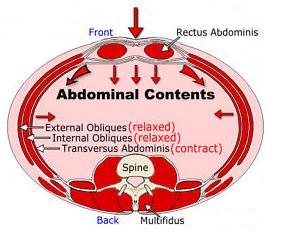 and they define the muscle structure that we call “core”. Two muscles of the core have been identified as being responsible for providing stability to the trunk in order to be able to move our bodies in an efficient way: the multifidus at the back and the transversus abdominis (TA) in the front. The TA is the deepest layer of abdominals that provides great support for the spine when activated correctly. It should fire just an instant before limb movement and failure to do so could result in lower back pain and/or poor body alignment. Hence the importance of being able to identify this muscle in our body and learn how to turn it on while working out.
and they define the muscle structure that we call “core”. Two muscles of the core have been identified as being responsible for providing stability to the trunk in order to be able to move our bodies in an efficient way: the multifidus at the back and the transversus abdominis (TA) in the front. The TA is the deepest layer of abdominals that provides great support for the spine when activated correctly. It should fire just an instant before limb movement and failure to do so could result in lower back pain and/or poor body alignment. Hence the importance of being able to identify this muscle in our body and learn how to turn it on while working out.
The TA acts as a local stabiliser and in order to get the TA firing when working out, we need to pick low load exercises over high load exercises, especially for those who are just beginning to understand how it works. In this way, the muscles closer to the joints are those that are really challenged as opposed to the global mobilisers like the rectus abdominis. For those who are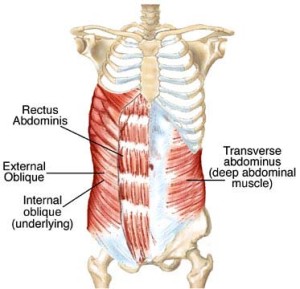 a little bit more advanced and have the TA activation already incorporated, we can introduce exercises where the base of support narrows or becomes less stable to push them and take their bodies into more challenging positions. We’ll try to avoid exercises where thoracic flexion is present to take the activation of the rectus and the obliques out of the equation. In Pilates we pay great attention to the TA activation, as it is important in every single move we perform. But there are some particular exercises that will help us achieve a better understanding of what it is and how it works.
a little bit more advanced and have the TA activation already incorporated, we can introduce exercises where the base of support narrows or becomes less stable to push them and take their bodies into more challenging positions. We’ll try to avoid exercises where thoracic flexion is present to take the activation of the rectus and the obliques out of the equation. In Pilates we pay great attention to the TA activation, as it is important in every single move we perform. But there are some particular exercises that will help us achieve a better understanding of what it is and how it works.
Laura Lo Bianco


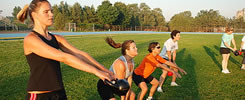

Speak Your Mind